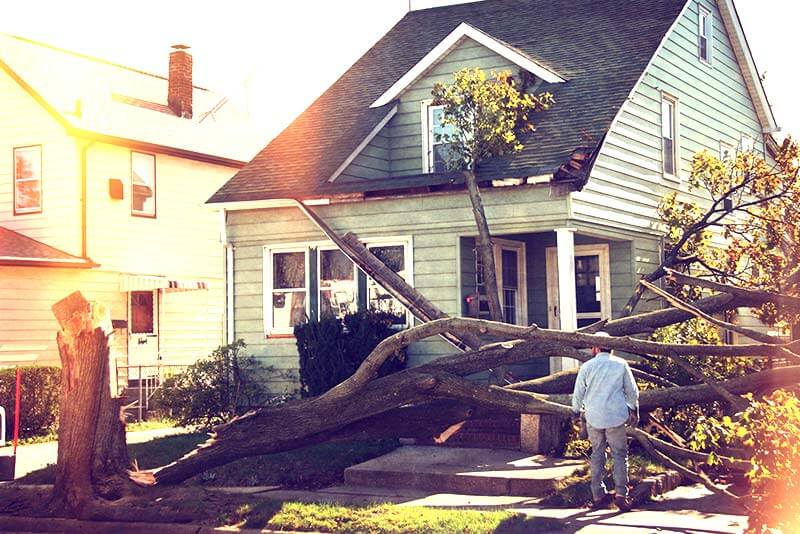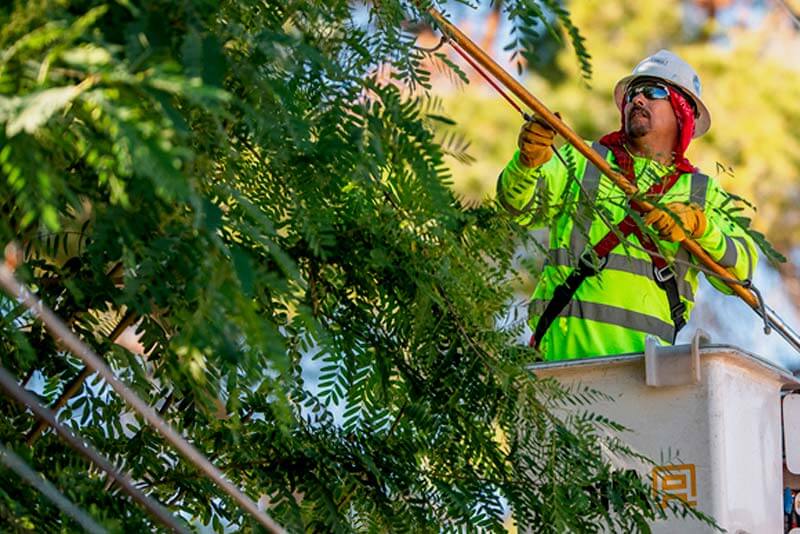If the tree is within your property, it will be your responsibility to trim, prune, or safely remove it to prevent damage to the power lines.
The electric utility company is responsible for repairing and restoring power if a tree falls on power lines. They are also responsible for the trees near the power lines.
Utility companies have a requirement of 15 feet minimum for the tree to be their responsibility.

What we cover
ToggleWhat to do if a power line falls on your house?
It is a dangerous situation to be in when a power line falls on your house. If you find a power line in one of your bedrooms or even in the living room, the safest thing you can do is to remain inside until you can contact your electric company.
Once you have contacted your electric company, they will cut the power to your home or the whole street. This is to make sure that you can safely exit the premises without having the fear of electrocution.
While waiting for the electric company to respond, do not run on any water and avoid touching anything metal at all costs. Stay in one area that’s dry.
If you ever need to leave your home right away due to damage or any other reason, exit your home as carefully as you can. Stay away from the downed wire and go through another exit door if available.
A tip to remember is to make sure that you do not lift your feet while shuffling away from your home to prevent electrocution. If the option is available, wear rubber-soled shoes to limit the transfer of electricity.
What to do if a power line falls in your yard?
To make sure your home, family, and pets stay safe, here are four simple steps you can follow if a power line falls in your yard.
1. Survey the area
Take a quick scan of the area where the downed power lines are. If you’re not exactly sure where it fell, trace where the power line came from by looking up and checking the connected lines. Sometimes, the wires can be hidden behind tall trees.
Make sure that there are no people or animals near the scene. Never try to approach the lines or touch them with a stick or any other object to move them. Electricity can still move through materials whether they are conductive or not.
Salt River Project (SRP) states that one should stay at least 100 feet away from a downed power line that has touched the ground. By doing so, the risk of getting electrocuted or shocked is reduced.
2. Look for signs of fire
Electrical sparks are possible on fallen power lines. They can cause fire and will make the situation more complicated and dangerous.
Look for possible signs of fire inside your home as downed power lines may cause a power surge that can overload electronics and electrical appliances.
3. Keep your distance
Stay as far away as possible from a fallen or downed power line. Even though you need to check the area and make sure that there are no signs of fire or people and animals near it, you still need to keep your distance.
Whether the power line is still live or non-functioning, it will be difficult to tell so the safest option is to assume it’s active and take precautions by staying away from it.
If you were inside your home as the power line fell into your yard, keep an eye on the situation but make sure you are a safe distance away. Do not leave your home until the electric company has completely shut your power off.
4. What to do if you are already outside
If you are outside, shuffle away from the area, and don’t lift your feet as you move away. Make sure that both of your feet are on the ground to reduce the chances of getting shocked.
If you are in a car, stay inside the vehicle. The tires of your car will help conduct the electric current down and into the ground. Therefore, your vehicle will be the only safest place for you to stay until the electric company cuts the power off.
5. Call 911 or the electric company
Call for help immediately if a power line is down or has fallen into or near your property. If you can do the 3 steps mentioned above while simultaneously calling for help, that will be the best option.
As soon as the current for the main line gets shut off by the electric company, it will be much safer for you to move and exit your home.
Who to call when a tree falls on a power line?
When trees start to contact or interfere with power lines, there is a great chance for the tree, the surrounding structures and human or animal lives to get affected or damaged.
It is important to know who to contact in a dangerous situation to keep harm away from people and minimize casualties. Restoring a safe environment is one of the responsibilities of the people in charge of power lines.
Call your electric utility company
The electric utility company that owns the power line is responsible for the repair and restoration of power if a tree falls on it. If you have their contact number available, inform them about the situation right away.
Call 911
You can always call 911 as well for emergencies like this especially when the power line is down due to a fallen tree. If you see a downed power line near you, call 911 immediately.
They can also contact the electric utility company for you so the power gets shut off in the entire area, making it safe for you, your family, and your neighbors.
Are trees touching power lines dangerous?
Yes, it can be very dangerous when trees touch power lines. Trees are able to carry electricity through them. With a high-voltage power line, it has a high possibility of shocking people.
It is a common misconception that power lines cannot electrify trees. If you ever come across a tree coming in contact with a power line, this can be very dangerous for you, your pets, and your neighbors.
In some situations, the power lines do not even have to touch the tree in order for it to be dangerous. A voltage surge can actually cause an arc from the transmission line.
This could lead to a fire or even enough to take a life. It is very important to be cautious of these things as it can be difficult to tell whether a tree has been electrified or not.
Can branches conduct electricity?
Branches can conduct electricity. A power line has the ability to energize a whole tree when it is in contact with each other. It could lead to electrocution by anyone touching it or it could cause a fire.
Because branches can conduct electricity, it is not advisable that you attempt to trim or cut down branches from trees that are near or touching the power line. Contact a professional even if the tree is on your property.
Who is responsible for trimming trees near power lines?
The electric utility company is responsible for trimming trees near power lines, especially when they come in contact with the power lines. This is a requirement by the National Electrical Safety Code.
Trees, shrubs, and other vegetation touching power lines are risky. It can cause safety hazards and power outages. This is why they should be regularly trimmed or pruned to promote safety.
Dead, dying, or diseased trees should also be removed near or over the power lines. Electric utility companies usually have a regular schedule for trimming vegetation every 6-12 months.
However, if the tree is on your property, you will be responsible for managing the situation and paying for the trimming cost yourself.
The landowners should always be responsible for maintaining and caring for the trees on their property, including trimming, pruning1, and removing.

Branch trimming near power lines cost
The overall cost of trimming a tree depends on many reasons. There are many factors to consider as some situations can be too specific and would require special treatment.
Generally, these reasons include the size of the tree and the number of branches to be trimmed or removed.
Considering the size, it would cost somewhere between $250 to $525 for small-sized trees that are near a power line. For medium trees, the cost would range from $290 to $720, including removing a moderate number of branches.
For large trees that measure 30 to 50 feet tall, the cost of trimming them would be somewhere around $500 to $1200. Larger trees that go up to 100 feet tall could cost up to $2000.
These estimates are subject to increase depending on how much trimming should be done to the tree as well as its size.
- William Elmendorf, (2022) Pruning for Utility Line Clearance. <https://extension.psu.edu/pruning-for-utility-line-clearance> Accessed: 19-02-2024




